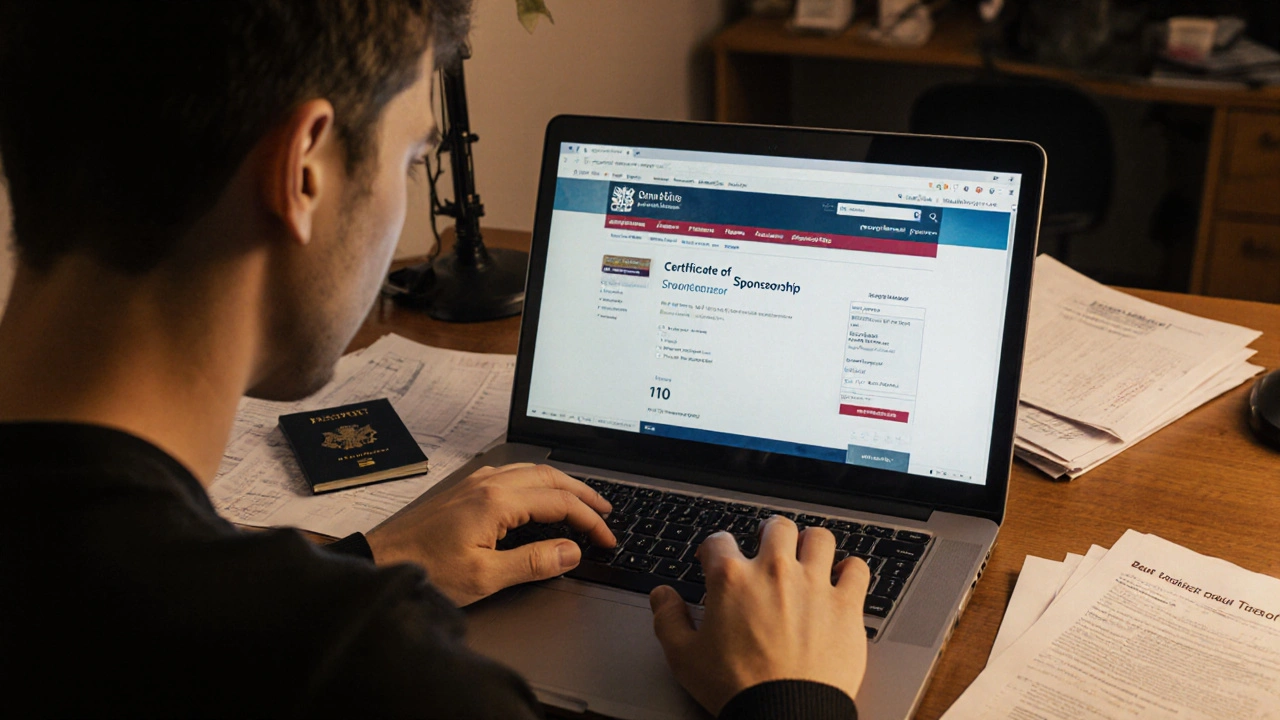Moving to London for a job isn’t just about finding an apartment or learning the Tube map. If you’re coming from outside the UK, the first real hurdle is getting the right visa. The Skilled Worker Visa is the main route for foreign workers to take up a job in London-and it’s not as complicated as it sounds if you know what to expect.
What Is the Skilled Worker Visa?
The Skilled Worker Visa replaced the old Tier 2 (General) visa in December 2020. It’s not a visa for tourists, students, or freelancers. It’s specifically for people who have a job offer from a UK employer that’s licensed to sponsor visas. That’s the key: no job offer, no visa. And the job must meet certain skill and salary thresholds.
London is the most common destination for this visa because it’s home to over 60% of all UK sponsor license holders. Companies like Barclays, NHS trusts, Google UK, and even small tech startups in Shoreditch can sponsor you-if they’re on the official Home Office list.
Eligibility: The Three Must-Haves
You can’t just apply because you want to live in London. You need three things:
- A job offer from a UK employer with a valid sponsor license
- The job must be on the approved list of eligible occupations
- You must meet the minimum salary requirement
Let’s break those down.
1. Your Employer Must Be a Licensed Sponsor
Your future employer can’t just say, “We’ll hire you.” They need to be officially approved by the UK government to bring in overseas workers. You can check if they’re licensed on the Home Office’s public register. If they’re not on it, they can’t sponsor you. Period.
Some companies have a whole team dedicated to visa applications. Others might not know where to start. If your employer says they’ve never sponsored anyone before, ask them to check the register. If they’re not there, they’ll need to apply-which takes 8 to 12 weeks. That delays your move.
2. Your Job Must Be on the Approved Occupation List
Not every job qualifies. The UK government has a list of roles that are considered “skilled.” These are mostly jobs that require at least A-level equivalent qualifications (RQF Level 3 or higher). Examples include:
- Software developer
- Nurse
- Architect
- Electrical engineer
- Marketing manager
- Senior teacher
You can find the full list on the UK government website. Each job has a specific Standard Occupational Classification (SOC) code. Your employer must assign the right one to your role. If they pick the wrong code, your application will be rejected.
3. Salary Requirements: The £38,700 Rule (or Lower)
The general salary threshold is £38,700 per year. But there are exceptions.
If your job is on the “Shortage Occupation List,” you might qualify with a lower salary-sometimes as low as £30,960. Jobs like nurses, physiotherapists, and certain engineering roles still count as shortage areas.
There’s also a “going rate” for each occupation. You must earn the higher of either £38,700 or the specific going rate for your job. For example, a junior software developer might have a going rate of £32,000. If you’re offered £34,000, you meet the requirement. If you’re offered £31,000, you don’t-even though it’s above £30,960.
Some roles, like new graduates or those under 26, can qualify at 70% of the going rate if they’re sponsored under a graduate route. But that’s a different visa.
The Application Process: Step by Step
Once you have your job offer, here’s what happens next.
Step 1: Get Your Certificate of Sponsorship (CoS)
Your employer gives you a Certificate of Sponsorship. This isn’t a physical document-it’s a unique reference number with details about your job, salary, and role. There are two types:
- Defined CoS: For new hires from outside the UK (this is what you’ll get)
- Undefined CoS: For people already in the UK switching visas
You must apply for your visa within 3 months of the CoS date. If you wait too long, it expires.
Step 2: Gather Your Documents
You’ll need:
- Your passport (valid for the full length of your stay)
- Your CoS number
- Proof of English language ability (if not from a majority English-speaking country)
- Proof of funds: £1,270 in your bank account for at least 28 days before applying
- TB test results (if you’re from a country on the UK’s list)
The £1,270 is for living costs. It doesn’t have to be your own money-you can use your partner’s if they’re applying with you. But you must show a bank statement with your name on it, or a letter from your sponsor confirming they’ll support you financially.
Step 3: Apply Online
Go to the official UK government visa portal. Fill out the form. You’ll answer questions about your job, your background, and your intentions. Be honest. If you say you plan to work for 5 years, but your contract is only for 1 year, that’s a red flag.
You’ll pay:
- £715 for the visa application (if applying from outside the UK)
- £715 for the immigration health surcharge (IHS)-this gives you access to the NHS
That’s £1,430 total. Paying this doesn’t guarantee approval, but skipping it means your application is incomplete.
Step 4: Book a Biometrics Appointment
After submitting your application, you’ll get a letter telling you where to go for fingerprints and a photo. In London, there are multiple visa application centers-Soho, Croydon, and others. Appointments fill up fast, so book as soon as you can.
Step 5: Wait and Receive Your Visa
Processing times vary. If you’re applying from outside the UK, you’ll usually get a decision within 3 weeks. You can pay £500 for a priority service and get it in 5 working days.
Once approved, you’ll get a digital visa linked to your passport. You’ll be able to enter the UK up to 14 days before your job starts. Don’t try to arrive earlier-you won’t be allowed in.

What Happens After You Arrive?
Once you land in London, you have 10 days to register with the police if you’re from a country that requires it (most aren’t anymore, but check your visa conditions).
You’ll also need to collect your Biometric Residence Permit (BRP) if you applied from outside the UK. It usually arrives by post within 7 to 10 days. Keep it safe. It’s your proof of right to work.
Your visa is usually granted for 5 years. After that, you can apply for Indefinite Leave to Remain (ILR)-the UK’s version of permanent residency-if you’ve stayed continuously, paid taxes, and met other requirements.
Common Mistakes That Get Applications Rejected
People get turned down for simple reasons:
- Using the wrong SOC code for their job
- Not showing the full £1,270 in savings for 28 days
- Submitting bank statements that are too old or don’t show the applicant’s name
- Trying to apply without a valid CoS
- Claiming English proficiency with a certificate that’s expired or not from an approved test provider
One real case: a graphic designer from Brazil was refused because his employer listed his job as “Graphic Designer” under SOC 2010 (old code). The new code is “Graphic Designer (Digital)” under SOC 2020. The system didn’t recognize it. He had to reapply with a corrected CoS-delaying his move by 3 months.
Can You Bring Your Family?
Yes. Your partner and children under 18 can apply as dependents. They’ll need to prove their relationship to you (marriage certificate, birth certificates). They’ll also pay the IHS fee and can work or study in the UK without restrictions.
They can apply at the same time as you or later. But if they come after you, they’ll need to show they’re joining you, not just visiting.

How Long Can You Stay?
Your initial visa lasts up to 5 years. After that, you can extend it if you still have a job with a sponsor. You can’t stay longer than 5 years on this visa unless you switch to another route.
After 5 years of continuous residence, you can apply for ILR. You must have:
- Not left the UK for more than 180 days in any 12-month period
- Passed the Life in the UK test
- Met the English language requirement (B1 level)
Once you get ILR, you can live and work in the UK permanently. After 12 more months, you can apply for British citizenship.
What If You Lose Your Job?
If you’re made redundant or quit, you have 60 days to find a new job with a new sponsor-or leave the UK. You can’t stay on this visa without a job.
Some people use those 60 days to switch to a different visa-like the Global Talent Visa if they’re in tech or science. But that’s a separate process.
Is This Visa Worth It?
London is expensive. Rent for a one-bedroom in Zone 2 can cost £2,000 a month. The visa costs £1,430 upfront. But if you’re in a skilled job, you’re likely earning £45,000 or more. After tax and rent, you can still save money.
And the benefits? Access to the NHS, a stable legal system, the chance to build a long-term future in one of the world’s most diverse cities. Thousands do it every year. It’s not easy, but it’s doable-if you plan carefully.
Can I apply for the Skilled Worker Visa without a job offer?
No. You must have a confirmed job offer from a UK employer with a valid sponsor license. There are no exceptions. If someone tells you they can get you a visa without a job, they’re misleading you.
How long does the Skilled Worker Visa application take?
If you’re applying from outside the UK, standard processing takes about 3 weeks. You can pay £500 for a priority service and get a decision in 5 working days. If you’re already in the UK switching visas, it can take up to 8 weeks.
Do I need to take an English test?
Yes-if you’re not from a majority English-speaking country and don’t have a degree taught in English. You need to pass an approved test at B1 level (equivalent to intermediate). Tests like IELTS for UKVI, PTE Academic, or Trinity College’s SELT are accepted.
Can I switch from a student visa to a Skilled Worker Visa?
Yes. If you’re on a Student Visa and you’ve completed your course, you can switch to the Skilled Worker Visa without leaving the UK-provided you have a job offer from a licensed sponsor and meet all other requirements.
What if my salary is below £38,700 but my job is on the shortage list?
You may still qualify. Jobs on the Shortage Occupation List can be sponsored at a lower salary-sometimes as low as £30,960. But you must still meet the higher of the going rate for your job or the reduced threshold. Always check the official list before applying.
Can I change jobs while on this visa?
Yes, but you must apply for a new Skilled Worker Visa with your new employer’s sponsorship. You can’t just switch employers without approval. Your new job must also meet the skill and salary requirements.
Do I need to pay the immigration health surcharge every year?
No. You pay the IHS once for the full length of your visa. For a 5-year visa, you pay £715 once. It covers you and any dependents for the entire period. You won’t pay again unless you extend or reapply.
